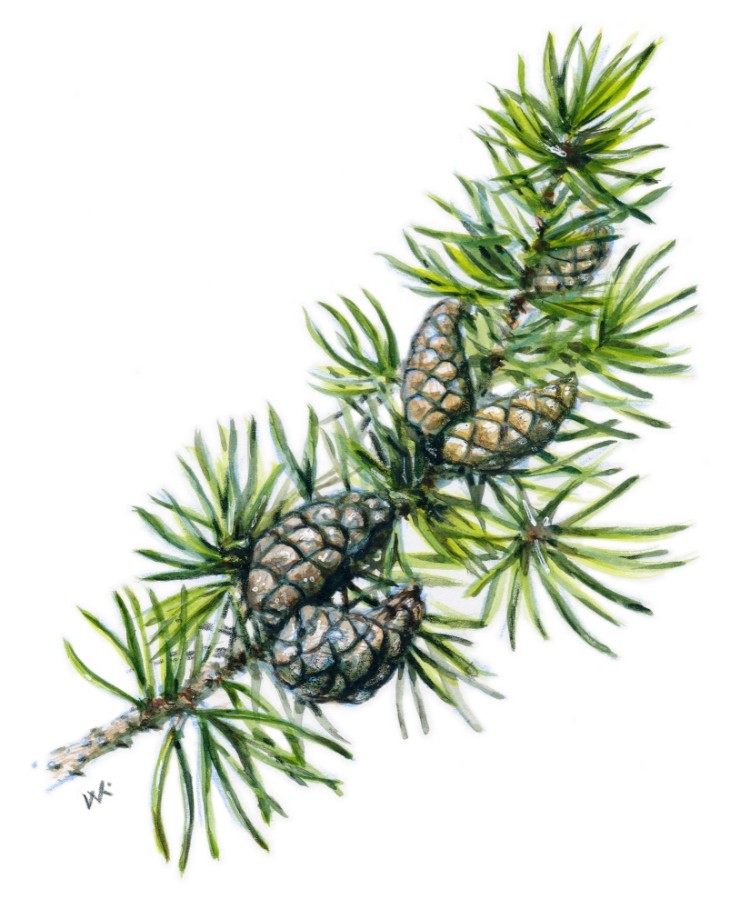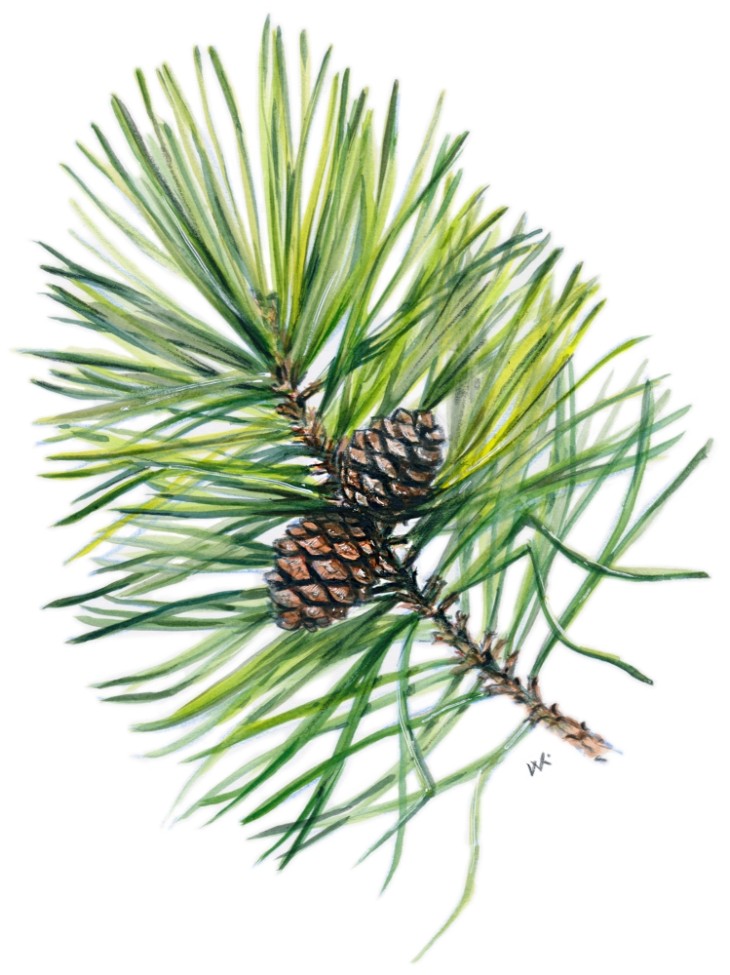
The New England – Acadian Forest ecoregion covers most of Maritime Canada, a slice of eastern Quebec, northern New England, and the Adirondack Mountains. Each conifer species in this region has a scientific name and one or more common names. The origins of the common names are frequently obscure but usually have some obvious link to these species, often related to the physical attributes of the trees. White pine takes its common name from the pale color of its wood, while red pine is covered in reddish brown bark and features a pale red heartwood. In colonial New England, pitch pine was the most important source of pitch and tar, resinous materials baked out of the pines in kilns and used primarily for waterproofing and sealing seams.
Latin scientific names are also frequently related to the traits of the plants, but in contrast to common names, scientific names have well-documented origins and are often connected to key figures in eighteenth- and nineteenth-century plant science. During this period, European botanists were developing shared and systematic ways to name plants. Ironically, few of these botanists would ever see North American conifers in their natural habitats. Instead, most stayed home, perused the observations of other botanists, and studied dried specimens and live plants grown from imported seeds and seedlings as they created the Latin names we use today.
American botanists were involved in describing, collecting, and shipping plant materials across the Atlantic. For example, the Philadelphia-based botanist John Bartram collected widely and created “Bartram boxes” to ship seeds and other specimens to his patrons in England. But the assigning of formal scientific names to American tree species was almost always done by European botanists, at least until the early 1800s.
In 1753, Sweden’s Carl Linnaeus (1707–1778), the father of modern biological taxonomy, published his landmark Species Plantarum, the first botanical work to consistently assign Latin binomial names to plants, using only two Latin words to name or distinguish one species from another. The first word in the binomial is the name of the genus – the taxonomic rank above species, often comprising many related species. The second word is the specific epithet, applied to one species only.
Linnaeus was not the first to propose a method for naming and differentiating species, but older naming methods had used polynomial, or multiword names to label specific types of organisms. Polynomial systems had the advantage of allowing botanists to create species’ names containing detailed descriptions. However, as the list of described species grew, polynomial names became increasingly unwieldy and difficult to use. When a newly discovered or newly documented species was morphologically similar to a previously named species, the words used for the older species name could apply equally well to the new species. To differentiate old from new, the new species name required additional words. As European nations expanded their colonial empires and global trading networks, new species poured into Europe from around the world, and it wasn’t hard to see that soon a single name could grow to be a page or more long. The binomial system swept away the clutter, and this approach is still used almost 300 years later.
In Species Plantarum, Linnaeus established the genus name Pinus for pine species. Pinus is the classic Latin name for cone-bearing tree, likely derived from the Greek word pitus, which also refers to cone-bearing trees.
After settling on a genus name, Linnaeus then had to decide which conifer species belonged in the genus Pinus. Taxonomists are often described as being lumpers or splitters. When confronted with a set of related or similar species, lumpers tend to classify these species into one genus, while splitters might take the same collection of species and put them in multiple genera, even if they have to create new genus names to do so. Linnaeus was a lumper. In Species Plantarum, he listed and described 12 conifer species under the genus name Pinus, including firs, spruces, and larches. He later added hemlocks. The assemblage of Pinus species was too diverse to fall under a single genus name, and later botanists would move spruce, fir, larch, and hemlock species to their own genera (Picea, Abies, Larix, and Tsuga respectively).
Following are the stories behind the Latin names of four of the New England – Acadian Forest’s Pinus species.
Eastern White Pine (Pinus strobus)
White pine was one of the Pinus species Linnaeus described in Species Plantarum, and he is credited with assigning it the specific epithet strobus, Latin for “pine cone” and derived from the Greek word strobos. The Greek term can be translated as “pine cone” but may also mean “a whirling motion” – likely referring in this case to the whorled structure of the cone.
Pitch Pine (Pinus rigida)
English botanist Philip Miller (1691–1771) assigned the specific epithet rigida to pitch pine. Latin for “rigid” or “stiff,” rigida refers to the stiffness of the cone scales. Miller used this name in the eighth edition of his very popular botanical reference guide, The Gardener’s Dictionary, published in 1768, although he had initially given the species a much longer name.
Miller was a leading English botanist of Scottish descent, chief gardener at Chelsea Physic (or Apothecary) Garden, and fellow of the Royal Society, the oldest national scientific institution in the world. For much of his life, Miller was reluctant to embrace the new Linnaean binomial system and continued to use Latin polynomials to name species.
In the 1764 (seventh) edition of his Dictionary, he gave the species name for pitch pine as Pinus foliis ternis, conis longioribus squamis rigidioribus, which translates to “pine with leaves of three, cones that are longer [with] scales that are rigid.” The species name was very descriptive, but a little wordy for an herbarium label and subject to manipulation and modification by other botanists who might add words in the future.
Eventually, Miller realized he was fighting a losing battle, and in the Dictionary’s eighth edition (and last edition of Miller’s lifetime), published in 1768, he threw in the taxonomic towel and conceded the ascendancy of the new method. Many of today’s Latin names for plant species come from this edition and the ones that followed. Miller changed his Latin name for pitch pine to the much simpler Pinus rigida, a label that gave a nod to his use of rigidioribus in the old polynomial species name.
Jack Pine (Pinus banksiana)
The specific epithet banksiana honors Sir Joseph Banks (1743–1820), a British botanist, naturalist, patron of science, and president of Britain’s Royal Society for more than 40 years. As a young man, he joined Lieutenant (later Captain) James Cook’s first voyage of exploration to the South Pacific (1868–1871). When Cook and his crew stepped onto the Australian continent for the first time at a bay near present-day Sydney, the fervent collecting efforts of Banks and his Swedish colleague Danial Solander (1733–1782) inspired Cook to name the site Botany Bay (a name soon linked to the first penal colony in Australia). As both the advisor to King George III and the Royal Society president, Banks promoted many additional scientific expeditions.
Banks was not responsible for the scientific name for jack pine; to have inserted his name into Pinus banksiana himself would have been an unbecoming act for a British gentleman. Banks’s good friend and colleague Aylmer Bourke Lambert (1761–1843), an English botanist, Royal Society member, and a founding fellow of the taxonomy-oriented Linnaean Society of London, gave the jack pine its scientific name. Lambert owned a large botanical library, 30,000 herbarium specimens, and the Boyton Manor estate in Wiltshire, where he grew many types of pines. In 1803, Lambert included a formal description of jack pine in his beautifully illustrated first edition of A Description of the Genus Pinus, with banksiana as a new Latin species name and Labrador pine as the common name. In this volume, Lambert noted, “As I am entirely obliged to Sir Joseph Banks for the first knowledge of this species, I have given it his name.”
It’s not clear why Lambert used “Labrador” in the common name for this pine. This species is rare in today’s Canadian province of Newfoundland and Labrador while being widespread throughout the rest of the nation. But Lambert never traveled to Canada, so his understanding of the tree’s distribution and the region’s geography may have been limited. Or in his day, the word Labrador may have applied to much larger area than it does today.
Today’s common name for P. banksiana, jack pine, dates back to at least the mid-1800s. However, it’s uncertain if the word jack refers to how the wood was used (it may have been used make small tools or “jacks”) or to the small size and scrubby growth form of this species compared to other pines. This species is a good example of the value of assigning a single Latin name to every species, as it has numerous other common names including gray (or grey) pine, scrub pine, Hudson Bay pine, and Bank’s or Banksian pine.
Red Pine (Pinus resinosa)
The specific epithet resinosa means resinous, an appropriate name for any pine species. Scottish-born Kew Gardens director, gardener, and botanist William Aiton (1731–1793) first published the name in 1789 in Hortus Kewensis, a catalog of plants cultivated at the gardens. It remains unclear which of the species names in his book he coined.
Hortus Kewensis drew heavily from a manuscript originally developed in the late 1760s by Solander, who had studied at Uppsala University under Carl Linnaeus. In 1760, Solander followed his mentor’s suggestion to travel to England to see the work of British botanists and to spread the new Linnaean system. With impressive recommendation letters and a talent for making friends, he was hired by the British Museum, a new institution established on a foundation of specimens donated by wealthy collectors. During the 1760s, Solander organized and cataloged the mountain of donated herbarium collections, which included specimens from North America, and produced manuscripts describing various plant species and naming them with proper Linnaean-style binomial species names.
He also created specialized boxes to store the prints, drawings, manuscripts, and herbarium materials related to given taxonomic categories. These boxes became known as Solander boxes, and botanists still use them today. In the late 1760s, Joseph Banks invited Solander to join the scientific team assembled for James Cook’s expedition to the South Seas, where he collected many more specimens to be described and catalogued. Solander died of a stroke at 49, and because he did not publish the vast majority of his manuscripts, he is little known today.
Nevertheless, Solander’s efforts were not wasted. During the 1780s, a fellow Swede and Linnaeus student, Jonas Dryander (1748–1810), continued to work with Solander’s materials, annotating and augmenting the old manuscripts. The Solander-Dryander manuscripts would form the scientific basis for Aiton’s Hortus Kewensis, and Dryander edited the work extensively. Aiton’s entry for Pinus resinosa bears no mention of Solander, and it’s unclear to what degree Aiton and Dryander relied on Solander’s original work in describing this species.
Because taxonomic rules state that the naming authority for a species sits with the person who first publishes or puts the name in print, Aiton usually receives credit for the name P. resinosa. However, in A Description of the Genus Pinus (1803), Aylmer Lambert gives credit for the species name to both the Solander manuscripts and to Aition in Hortus Kewensis. Thus, the authority or naming credit for P. resinosa sometimes appears as “Sol. ex Aiton,” meaning “Solander through Aiton.” Some twentieth-century texts go so far as to list Daniel Solander as the sole authority for P. resinosa.






Discussion *